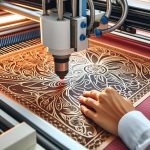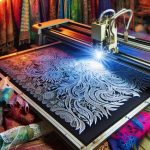You might think laser cutting for textiles is too advanced, but with the right guidance, it's quite manageable. By choosing a laser cutter that fits your budget and project needs, you can achieve precision and efficiency right from the start. Understanding which materials work best and mastering basic techniques, such as setting parameters and securing fabric, are essential steps. Additionally, familiarizing yourself with design software and adhering to safety protocols will set you on the right path. Ready to explore these aspects further? Let's get started on transforming your textile projects with laser cutting.
Table of Contents
Key Takeaways
- Choose a laser cutter with adjustable power settings and a user-friendly interface for varied textile applications.
- Test different fabrics like cotton, silk, polyester, nylon, and felt to determine suitable materials for laser cutting.
- Secure fabric tightly and use fine-tipped nozzles to enhance cutting precision and prevent material shifting.
- Seal fabric edges post-cutting to avoid fraying and maintain clean lines.
- Use compatible design software like Adobe Illustrator or CorelDRAW to create scalable and precise cutting patterns.
Choosing the Right Laser Cutter
Selecting the right laser cutter for textiles can greatly impact the efficiency and quality of your projects. First, let's talk about budget considerations and size requirements. You need to balance your investment with the scale of your operations. If you're running a small studio, a compact, cost-effective model might suffice. However, for larger production volumes, investing in a more substantial machine will pay off in the long run.
Next, power capabilities and precision needs are critical factors. The power of the laser cutter determines how quickly and cleanly it can slice through various fabrics. For intricate designs, you'll want a machine with high precision capabilities. Look for models with adjustable power settings to handle delicate materials without damage. High power isn't always better; it's about finding the right balance for your specific textile applications.
Additionally, consider the machine's software compatibility and ease of use. User-friendly interfaces can streamline your workflow, allowing you to focus more on creativity and less on troubleshooting technical issues.
Ultimately, the right laser cutter should meet your budget, fit your workspace, and deliver the power and precision needed to bring your textile designs to life.
Suitable Textile Materials
When deciding which textiles to use with your laser cutter, you'll want to focus on materials that respond well to the laser's heat and precision. The right fabric types can make all the difference in achieving clean cuts and intricate designs. Natural fibers like cotton and silk tend to work exceptionally well, while synthetic fabrics such as polyester and nylon also yield excellent results. However, each material has its limitations, so understanding these can help you make the best choice for your projects.
Here's a quick reference table for suitable textile materials:
| Fabric Type | Advantages | Limitations |
|---|---|---|
| Cotton | Cuts cleanly, minimal fraying | Can burn if power too high |
| Silk | Fine, precise cuts | Delicate, can scorch easily |
| Polyester | Melts to seal edges | Risk of toxic fumes |
| Nylon | Durable, clean edges | Melting can cause discoloration |
| Felt | Cuts well, no fraying | Thickness can vary |
These fabric types are popular choices because they respond predictably to laser cutting. Always test a small piece first to understand how the material reacts to the laser. By knowing the material limitations, you can adjust the settings accordingly and achieve professional-grade results.
Essential Laser Cutting Techniques
Mastering necessary laser cutting techniques ensures you achieve accurate, clean cuts and intricate designs with your textiles.
First, focus on cutting precision. Setting the right laser parameters—power, speed, and frequency—is vital. Adjust these based on the fabric's thickness and type to avoid fraying and burning. Always conduct test cuts on scraps to fine-tune your settings.
Fabric manipulation is another key aspect. Secure your fabric tightly on the cutting bed to prevent shifting. Use a low-tack adhesive or a vacuum table to hold the fabric in place. Properly aligned material ensures consistent cuts, reducing waste and enhancing your project's quality.
Edge sealing is important for preventing fraying, especially with synthetic fabrics. The laser's heat naturally seals edges during cutting, creating a clean finish. For natural fibers, consider applying a liquid edge sealer post-cutting to maintain integrity.
Detail work requires a steady hand and precise settings. Use fine-tipped nozzles and adjust the laser's focus for intricate patterns. Slower cutting speeds often yield better results for detailed designs. Always monitor your work closely to make real-time adjustments, ensuring every piece meets your high standards.
Design and Software Tips
Access the full potential of your laser cutting machine by leveraging the right design software and techniques. Start with creative inspiration, considering your color palette selection to make your textile designs stand out. Choose software that supports design scalability and file compatibility to make your workflow smoother.
Popular design software options include Adobe Illustrator, CorelDRAW, and Inkscape. These platforms offer robust tools to create intricate designs and adjust them to various sizes without losing quality. Pay attention to file formats—most laser cutters work well with vector files like .AI, .EPS, and .SVG. Confirming your design files are compatible can save you time and prevent errors.
Here's a quick reference table to help you with software choice and considerations:
| Software | Key Features |
|---|---|
| Adobe Illustrator | Advanced vector tools, excellent design scalability, extensive file compatibility |
| CorelDRAW | User-friendly interface, inclusive color palette selection, scalable designs |
| Inkscape | Free and open-source, strong vector support, good file compatibility |
| AutoCAD | Precise engineering tools, high scalability, supports multiple file formats |
Master these tools and techniques to elevate your textile projects. Keep experimenting with different designs, color palettes, and software functionalities to discover what works best for you.
Safety and Maintenance Tips
Optimizing the safety and longevity of your laser cutting machine requires diligent attention to maintenance and operational guidelines. First, adopt robust safety precautions. Always wear appropriate protective gear, such as safety goggles and gloves, to shield yourself from potential laser exposure and debris.
Establish a strict maintenance schedule to keep your machine in peak condition. Regularly clean the lens and mirrors, and check for wear and tear on belts and other moving parts.
Proper ventilation is essential. Laser cutting generates fumes and particles that can be harmful if inhaled. Make sure your workspace has adequate exhaust systems to remove these byproducts. This not only protects your health but also prevents residue buildup on the machine, which can affect performance.
Fire prevention is equally vital. Textiles are flammable, and the laser's high heat can ignite them. Keep a fire extinguisher nearby and optimize that the machine has an automatic shutoff feature in case of emergency. Additionally, never leave the machine unattended while it's operating.
Frequently Asked Questions
What Are the Common Applications of Laser Cutting in the Textile Industry?
Laser cutting in textiles is like an artist's brush, creating precise cuts and intricate designs. You'll see laser cutting for silk scarves and custom laser designs for fashion trends, revolutionizing the industry's approach to creativity and detail.
How Do Laser-Cut Edges Compare to Traditional Cutting Methods in Textiles?
You'll find laser-cut edges offer superior edge quality and precision compared to traditional methods. They're more efficient and faster, reducing fraying and saving time. Mastering this technique elevates your textile projects to a professional level.
Can Laser Cutting Be Used for Intricate Lace Patterns in Fabrics?
Imagine a wizard's wand crafting delicate designs. Yes, you can use laser cutting for intricate lace patterns in fabrics. The lace precision and fabric intricacy achieved are unparalleled, offering you mastery over complex textile designs.
What Is the Average Cost of a Laser Cutter for Textile Applications?
When considering the cost of a laser cutter for textiles, you should expect to spend between $3,000 and $10,000. Cost comparison and budget considerations are essential to make sure you get the best machine for your needs.
How Does Laser Cutting Affect the Durability of the Finished Textile Product?
Laser cutting can enhance material longevity by providing clean, precise edges that reduce fraying. It also improves wear resistance, ensuring your textile products maintain durability and high performance even after repeated use and washing.
- Jaclyn Smith Fabric Coconut: a Review of This Rayon/Polyester Blend - June 29, 2025
- Jaclyn Smith Fabric Coconut: a Review of This Rayon/Polyester Blend - June 29, 2025
- How to Get Coconut Oil off Fabric Without Washing - June 29, 2025







